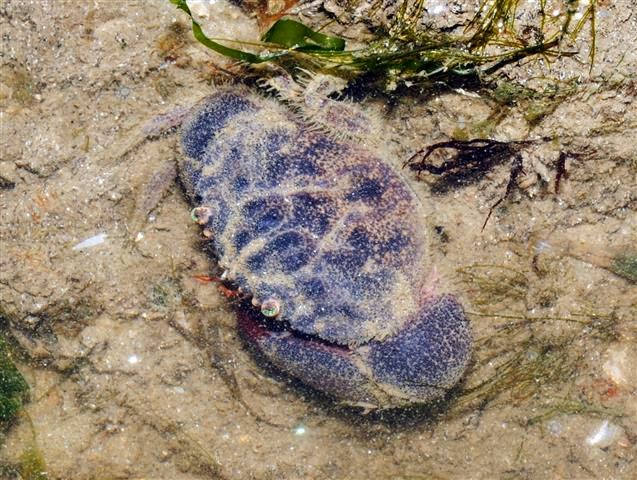There's lots of crap crabs at Punggol where James and I visited this shore on a wee hour of 0430. This also marked the end of the morning low spring tide field trips for 2014!
There was another unidentified crab that was even more tiny and weeny! May be a juvenile or something!
The usual
James found this crab with red claws! I don't know what this crab is but it does look interesting. Could be a juvenile of one of the common crabs.
Found on the seaweed is this Blue swimming crab (Thalamita sp.). They are usually quite active at night and would likely move away quickly when I walk close to them.
A nice surprise for us would be this huge Mud crab (Scylla sp.)! These are usually the crabs that we consume on our dining tables with dishes such as the pepper crab or chilli crab.
What is this lump doing on the shore? Is this a living creature?
It is actually a cute Sponge crab (Family Dromiidae) with pink tipped claws that uses stuffs like sponges to cover itself as a form of camouflage. We saw two of them on this trip.
After so many visits to Punggol, I went round the corner to another stretch for the first time! This stretch of shore is closer to Coney Island or Pulau Serangoon. Something different about this shore as compared to the usual stretches would be the presence of Cerianthids (Order Ceriantharia).
As the low water mark was rather calm, we could see many of these Cerianthids with their tentacles wide open submerged in the water. It's like an underwater garden!
There were also several Plain sand stars (Astropecten indicus) found on the sandy areas. I don't usually see them on the areas that we used to survey.
There was also a small Painted sand stars (Astropecten sp.) where three of its arms are regenerating.
This pinkish worm looks like the Reef bristleworm (Eurythoe complanata). They are also known as fire worms.
Fireworms have bristles which are brittle and contain poisons. The hairy bristles are sharp and can easily penetrate bare skin. Therefore, do not touch everything that you see on the shore. :)
Here is a better photo with the flatworm submerged in a small tide pool. It does look quite graceful though it is a.... worm. :P
As like the previous trip, the sponges are not too extensive and there is lesser variety as compared to 4 years ago.
Going back to the usual stretch, the Spoon seagrass (Halophila ovalis) or Hairy spoon seagrass (Halophila decipiens) are still around!
There were several clumps of Glassy branching bryozoan found on the shore. Though they look like plants, bryozoans are colonies of animals that grows among seaweeds and seagrasses. Bryozoans are minute individual animals with internal organs.
The first and last time I saw these Okenia pellucida slugs was also at Punggol in 2013 and they were on the branching bryozoans. Glad to know that they are still around! The lines on the pale yellow body are pretty and look like they were intricately carved.
Another sluggy find would be this Volvatella slug (Volvatella vigourouxi) found among the seaweed.
The jetty legs are full of life! Though more or less spongeless, there are many Green mussels (Perna viridis), Knobbly soft corals (Carijoa sp.), colourful Blob ascidians and Bryozoans (Phylum Bryozoa)- in sequence from top left, top right, bottom left and bottom right.
There are also some Black sea urchins (Temnopleurus sp.) hanging on tenaciously onto the jetty legs.
A special find would be many of these unknown anemones with an orange outer ring of tentacles and greenish inner row of tentacles on the oral disk. It's nice to be still finding new stuffs after visiting the same shore several times.
That's all for all the sleep deprivation to wake up at unearthly hours for this year! Though the evening tides are more bearable, they are not so low and there are not so many dates. Nevertheless, there will still be some adventures coming up later this year. So do keep a lookout!




























No comments:
Post a Comment